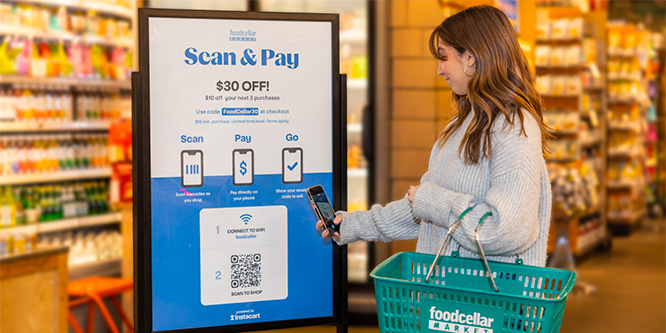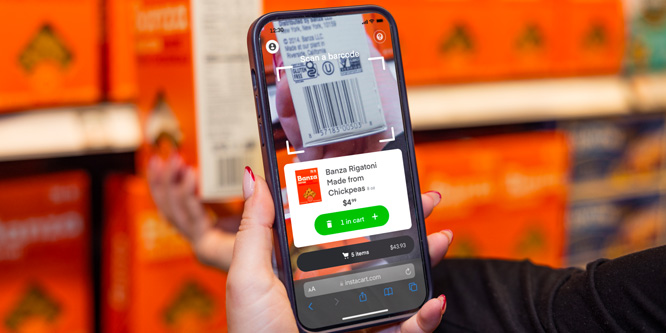
Photo: Instacart
Instacart enters the competition for in-store scan-and-go
Instacart has become a major part of how many Americans shop for groceries online. Now it is moving ahead with plans to become a fixture of how they shop in stores, as well.
The company recently announced the first full implementation of its Scan & Pay solution. A few weeks ago, Long Island City grocery store Foodcellar Market deployed the solution, which allows customers to scan both center-store products and produce with their own smartphones and check out from anywhere in the store. Customers launch the solution by scanning a QR code on a sign at the front of the store, scanning items as they shop, checking out and displaying a QR code generated on their phone to confirm payment before they exit the store.
The solution, which is accessed via a mobile browser rather than an installed application, also links items purchased in-store to a customer’s Instacart account, to make future Instacart shopping easier. Scan & Pay has so far been utilized primarily during peak hours (1 p.m. to 5 p.m.) for baskets of 10 items or less. Instacart offers the solution as part of its Connected Stores technology bundle.
Connected Stores also includes Instacart’s AI-powered Caper Carts and Carrot Tags, electronic shelf tags, which can interact with shoppers’ smartphones, according to TechCrunch.

Retailer success with scan-and-go technology has been mixed. On one hand, Sam’s Club’s app has proven very popular. It was downloaded 9.6 million times in 2020, according to a press release. The retailer in 2021 added a Scan & Ship feature to let customers scan products in-store and have them delivered to their homes. Wegmans, on the other hand, notoriously had to discontinue its SCAN app late in 2022 because it generated an unsustainable level of shrinkage.
Instacart appears to be trying to address potential shrink concerns, stating that its “continuing development of Scan & Pay’s loss prevention capabilities is based on over a decade of experience working across the grocery industry, using Instacart’s deep understanding of the signals and patterns that indicate potential fraud.”
Retailers using the Instacart solution are able to monitor transaction data in real-time.
- Foodcellar Market Introduces Scan & Pay Checkout Technology Powered by Instacart – Instacart
- Instacart launches Connected Stores, a suite of in-store tech for retailers – TechCrunch
- Sam’s Club Evolves its Scan & Go App, Merging Digital and Physical Experiences – Sam’s Club
- Shoplifters force Wegmans to pull the plug on its self-scanning app – RetailWire
Discussion Questions
DISCUSSION QUESTIONS: Is there significant demand for scan and pay apps? Does Instacart’s version appear to address shrink and other operational concerns?


Until those “loss-prevention capabilities” are firmly embedded in the process, scan-and-pay is a questionable proposition. Is it even affordable if it has to be 99 percent foolproof?
Exactly my thought. It feels like the issues that retailers like Wegmans experienced with self-checkout would be exacerbated by making it even easier to “check out” with out any control. Conceptually, this makes sense; practically, more work needs to be done to protect the retailer from spiraling shrink costs.
Really? Seems like they are adding a cumbersome (and likely costly to retailers) process to the customer experience to help solve a shrink problem that I am not sure they have solved. Consumers that like Just Walk Out experiences are not being asked to scan a code for every item in the basket.
This QR-based approach is an interesting, almost low-tech way to do self-checkout. It’s essentially the same model as paying the restaurant bill via a QR code app. But it’s also an LP nightmare. The customers are almost impossible to control with no central queue. How do you deal with mis-scans? And what is the actual process of “displaying a QR code generated on their phone”? How do you identify fraudulent behavior when even the best video analytics companies in the world can really only do it in checkout mode, focused on a specific lane? Sorry, but I’m not buying the claim that being in the business for 10 years means you’ve solved the shrink problem. Some major retailers have been in business for more than a hundred years, and they’re still trying to figure this out. Let’s just say that a decade worth of experience means you’re still a pre-teen. So, would you trust your company’s business to a 10-year-old?
Excellent points Ken! I am not convinced that Instacart has solved the loss prevention issue. Instacart stating that its “continuing development of Scan & Pay’s loss prevention capabilities is based on over a decade of experience working across the grocery industry, using Instacart’s deep understanding of the signals and patterns that indicate potential fraud,” is a completely unsubstantiated statement. Personally I am a proponent of scan and go, but there needs to be some type of random audit of customers to help reduce fraud.
Instacart’s technology could very well be a tipping point in the scan-and-pay space, particularly with its ability to analyze and understand potential fraud patterns. The overall ease of scanning the QR code at the store, scanning items while shopping and then displaying another code for payment proof is not perfectly seamless, but getting closer to a near touch-less, scan-less experience. With Instacart’s innovative engineers and computer scientists, this experience is closer than you’d think.
There’s significant demand for frictionless shopping. Rigorously tested, reliable scan and pay apps can help shoppers skip long checkout lines.
Instacart seems to address the issue of PLUs vs. barcodes with Caper Cart scales and barcode scan issues with Carrot Tags. In-store sensors can also mitigate security risks like shrink.
Overall, Instacart appears to offer an integrated in-store tech system rather than a scan-and-pay silo.
Instacart has a very fundamental problem – there’s simply not enough demand for what it offers to make a long term business. And that includes in store options like this.
Low demand and technology that creates more problems than it fixes.
Didn’t we just comment on Wegmans abandoning their scan and go technology? I’m not reading any “we’ve conquered shrink” boasts in the Instacart announcement. Presumably it will be just as easy to cheat their system as it is anyone else’s.
So the “shopper” shows a code to the clerk, who waves them on through … only to find out later the store isn’t part of Instacart (and the code was a fake)? OK, that may not happen, at least exactly, but I have no trouble imagining something similar (particularly if a number of competing apps develop).
I don’t know whether there’s a demand for scan and pay or not, but it seems like a mild form of insanity to be promoting something which (IMHO) has an even greater potential for loss than the current self-scanning (which stores are complaining about).
Actually I think this may be the breaking point between “visionaries,” who see the security issues as a minor glitch, and the people who actually run stores, who see them as a deal breaker.
Yes 100%. And the “minor glitch” numbers that visionaries might feel is “simply a cost of doing business” is something grocery owners, operators take very seriously. They know this financial impact on the business is substantial enough to delay giving raises, investing in training, remodeling a new store, etc.
I’d love to see, compare these numbers to the best practices. I’m not sure another handheld tool by customers (a mobile phone-driven product) with a little video augmentation can outsmart suspecting shoppers navigating down aisles who assume someone won’t inspect their basket before they leave. And if caught, it continues to sound like “Oh, I must have forgot to scan this/these items.”
The best current options continue to be Just Walk Out tech or scanning products at checkout in a queue where employees and cameras keep an eye on things.
There is only upside for scan and go technology in-store. But this will be a slow rise as consumer behavior has not yet caught up. Consider how long it took self-checkout lanes to gain scale. Scan and go has a ways to go. Still, it’s good to see this in-store innovation moving in the right direction.